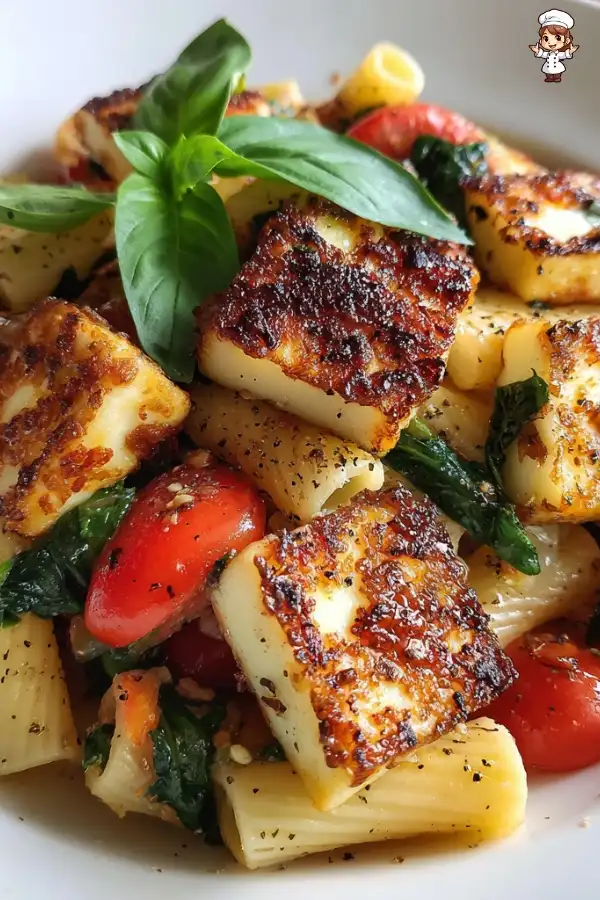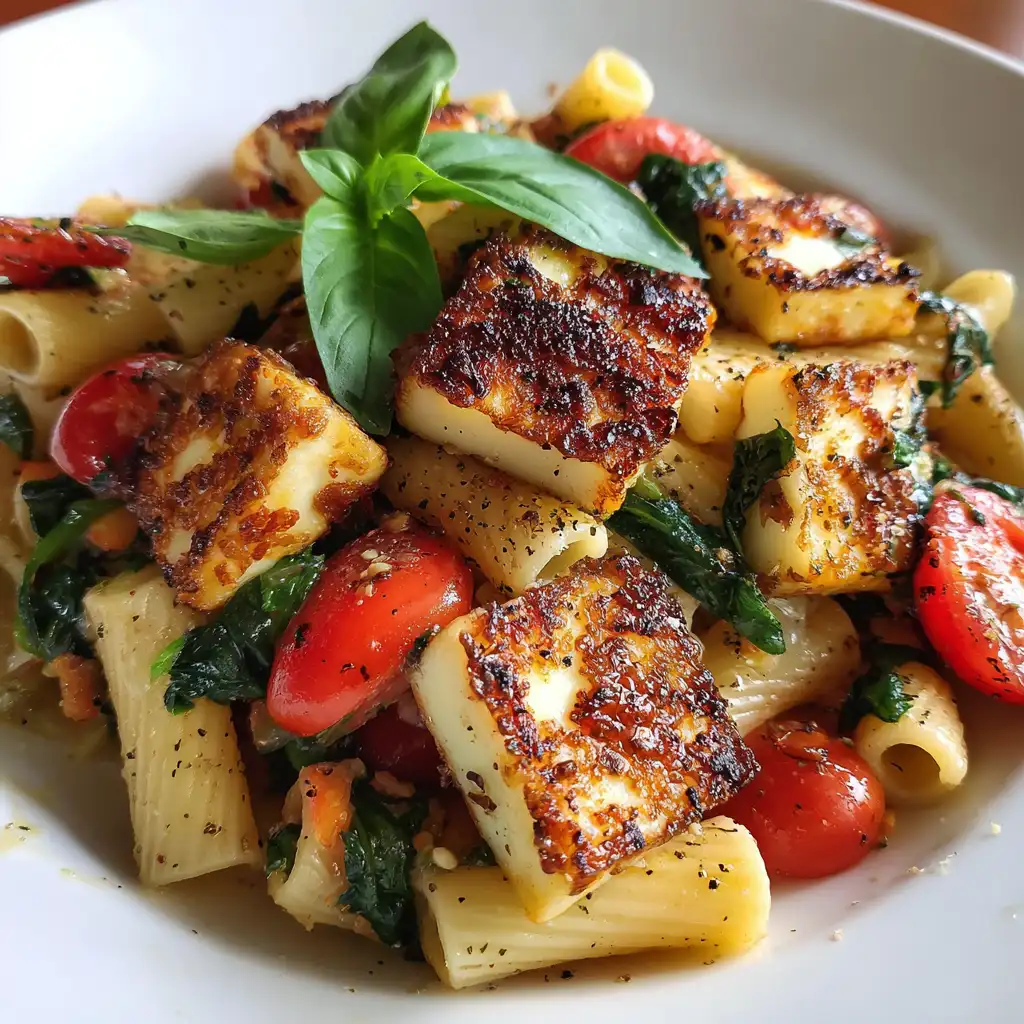Halloumi cheese is a unique and delicious cheese that originates from Cyprus. It is made from a mixture of goat’s and sheep’s milk, giving it a rich flavor and a firm texture. One of the best things about halloumi is its high melting point. This means it can be grilled or fried without losing its shape. When cooked, halloumi develops a golden crust while remaining soft and chewy inside. This delightful contrast makes it a favorite in many dishes, especially in a halloumi pasta recipe.
Why Choose a Halloumi Pasta Recipe?
Choosing a halloumi pasta recipe is a fantastic way to enjoy a meal that is both satisfying and flavorful. Halloumi adds a unique taste and texture that elevates any pasta dish. The combination of crispy halloumi, fresh vegetables, and perfectly cooked pasta creates a delightful experience for your taste buds. Plus, this dish is quick and easy to prepare, making it perfect for busy weeknights or casual gatherings with friends. With its vibrant colors and delicious flavors, a halloumi pasta recipe is sure to impress anyone at your table!
Ingredients for Halloumi Pasta Recipe
To create a delicious halloumi pasta recipe, you’ll need a few simple ingredients. Each component plays a vital role in building flavor and texture. Here’s what you’ll need:
- 200 grams of pasta: You can choose any type you like, such as penne, spaghetti, or fusilli. Each shape will bring a different experience to your dish.
- 250 grams of halloumi cheese: Cut into cubes, this cheese is the star of the show. Its unique texture and flavor will shine through in every bite.
- 200 grams of cherry tomatoes: Halved, these juicy tomatoes add sweetness and a burst of color to your pasta.
- 2 cloves of garlic: Minced, garlic brings a wonderful aroma and depth of flavor to the dish.
- 150 grams of fresh spinach: This leafy green adds a pop of color and nutrients, making your meal healthier.
- 3 tablespoons of olive oil: Used for sautéing, olive oil enhances the flavors of the ingredients and adds richness.
- 1 tablespoon of lemon juice: A splash of lemon juice brightens the dish and balances the richness of the halloumi.
- Fresh basil leaves: For garnish, these aromatic leaves add a fresh touch and enhance the overall presentation.
- Salt and pepper: To taste, these basic seasonings will help bring all the flavors together.
Gathering these ingredients will set you on the path to creating a delightful halloumi pasta recipe. Each item contributes to a harmonious blend of flavors that will leave you craving more!
Preparation of Halloumi Pasta Recipe

Step 1: Cooking the Pasta
To start your halloumi pasta recipe, you need to cook the pasta. First, fill a large pot with water and add a generous amount of salt. Bring the water to a rolling boil. Once boiling, add your chosen pasta. Cook it according to the package instructions until it reaches an al dente texture. This usually takes about 8 to 12 minutes, depending on the type of pasta you select. Remember to reserve about 1 cup of the pasta water before draining. This starchy water will help bind your dish later. After draining, set the pasta aside while you prepare the other ingredients.
Step 2: Preparing the Halloumi
Next, it’s time to prepare the halloumi. Cut the cheese into bite-sized cubes, ensuring they are uniform for even cooking. In a large skillet, heat 2 tablespoons of olive oil over medium heat. Once the oil is hot, carefully add the halloumi cubes. Cook them for about 2 to 3 minutes on each side. You want them to turn a beautiful golden brown and become crispy. Once done, remove the halloumi from the skillet and set it aside. This step is crucial as it adds a delightful texture to your halloumi pasta recipe.
Step 3: Sautéing the Vegetables
Now, let’s sauté the vegetables. In the same skillet, add the remaining tablespoon of olive oil. Once heated, toss in the minced garlic. Sauté it for about 30 seconds until it becomes fragrant. Be careful not to burn it! Next, add the halved cherry tomatoes. Cook them for about 3 to 4 minutes, allowing them to soften and release their juices. This will create a lovely sauce base for your pasta. After that, stir in the fresh spinach. Cook for an additional 2 minutes until the spinach wilts down. This adds a vibrant color and nutrients to your dish.
Step 4: Combining Ingredients
With the vegetables ready, it’s time to combine everything. Add the cooked pasta to the skillet with the sautéed garlic, tomatoes, and spinach. Toss everything together gently. If the mixture seems dry, add a splash of the reserved pasta water. This will help the ingredients blend beautifully. Finally, return the crispy halloumi to the skillet. Drizzle the mixture with lemon juice and season with salt and pepper to taste. Toss everything gently until well combined, ensuring every bite is packed with flavor.
Step 5: Serving the Halloumi Pasta
Your halloumi pasta is now ready to be served! Plate the pasta in bowls or on a large serving dish. For a finishing touch, garnish with fresh basil leaves. This not only adds a pop of color but also enhances the aroma. Enjoy your vibrant dish warm, relishing the delightful contrast of textures and flavors. This halloumi pasta recipe is sure to become a favorite in your home!
Tips for Perfecting Your Halloumi Pasta Recipe
Choosing the Right Pasta
When it comes to your halloumi pasta recipe, the type of pasta you choose can make a big difference. Opt for pasta shapes that hold onto the sauce well. For instance, penne or fusilli are great choices because their ridges catch the sauce and ingredients beautifully. Spaghetti is also a classic option, offering a delightful twirl of flavors. Remember, the cooking time may vary depending on the pasta type, so always check the package instructions. This way, you’ll ensure your pasta is perfectly cooked and ready to absorb all the delicious flavors!
Best Vegetables to Pair with Halloumi
Halloumi pairs wonderfully with a variety of vegetables. While cherry tomatoes and spinach are fantastic, you can also experiment with other options. Consider adding bell peppers for sweetness or zucchini for a mild flavor. Broccoli or asparagus can add a nice crunch and extra nutrients. If you enjoy a bit of spice, try incorporating some sliced jalapeños or red pepper flakes. Mixing different vegetables not only enhances the taste but also adds vibrant colors to your dish, making it visually appealing!
Storage Tips for Leftover Halloumi Pasta
If you have any leftover halloumi pasta, storing it properly is key to maintaining its flavor and texture. Place the pasta in an airtight container and store it in the refrigerator. It’s best to consume it within two days for optimal freshness. When you’re ready to enjoy it again, reheat gently in a skillet over low heat. You can add a splash of water or olive oil to help revive the dish and prevent it from drying out. This way, you can savor the deliciousness of your halloumi pasta even after the first serving!
Variations of Halloumi Pasta Recipe
Adding Proteins to Your Halloumi Pasta Recipe
If you want to boost the protein content of your halloumi pasta recipe, consider adding some delicious proteins. Grilled chicken or shrimp can be excellent additions. Simply cook them separately and toss them in with the pasta at the end. For a heartier meal, you might also try adding chickpeas or lentils. These legumes not only provide protein but also add a lovely texture. If you’re a fan of seafood, flaked salmon or tuna can also complement the flavors beautifully. Each protein option brings its unique taste, making your halloumi pasta even more satisfying!
Vegetarian and Vegan Alternatives
For those following a vegetarian or vegan diet, there are plenty of alternatives to enjoy this halloumi pasta recipe. If you want to keep it vegetarian, you can replace halloumi with a similar cheese like feta or paneer. These cheeses will still provide a delightful texture and flavor. For a vegan option, consider using tofu or tempeh. Marinate and sauté them until golden brown for a tasty substitute. Additionally, you can use nutritional yeast to add a cheesy flavor without dairy. These alternatives ensure everyone can enjoy a delicious pasta dish!
Flavor Enhancements for Halloumi Pasta Recipe
To elevate your halloumi pasta recipe, consider adding flavor enhancements. Fresh herbs like parsley or oregano can brighten the dish. A sprinkle of red pepper flakes can add a nice kick if you enjoy some heat. You might also try a splash of balsamic vinegar for a tangy twist. For a richer taste, consider adding a dollop of pesto or sun-dried tomato paste. These additions will create layers of flavor, making your dish even more exciting. Experimenting with different flavors can lead to a unique halloumi pasta recipe that you’ll love!
FAQs About Halloumi Pasta Recipe
Can I use other types of cheese in a halloumi pasta recipe?
Absolutely! While halloumi is a fantastic choice for its unique texture, you can experiment with other cheeses. Feta cheese is a popular alternative, offering a crumbly texture and tangy flavor. If you prefer a creamier option, try using goat cheese. For a firmer texture, paneer works well too. Each cheese will bring its own character to the dish, so feel free to get creative!
How do I make a halloumi pasta recipe gluten-free?
Making a halloumi pasta recipe gluten-free is simple! Just swap regular pasta for gluten-free pasta made from rice, quinoa, or lentils. These alternatives are widely available and cook similarly to traditional pasta. Always check the packaging for cooking instructions, as gluten-free pasta may require different cooking times. This way, you can enjoy a delicious halloumi pasta dish without any gluten!
What are some common mistakes to avoid in a halloumi pasta recipe?
When preparing your halloumi pasta recipe, there are a few common mistakes to watch out for. First, avoid overcooking the pasta. It should be al dente, as it will continue to cook when mixed with the hot ingredients. Second, don’t skip the step of reserving pasta water. This starchy water helps bind the dish together. Lastly, be careful not to burn the garlic while sautéing, as it can turn bitter. Keeping these tips in mind will help you create a perfect dish every time!
How can I make my halloumi pasta recipe more flavorful?
To enhance the flavor of your halloumi pasta recipe, consider adding fresh herbs like basil or parsley. A sprinkle of red pepper flakes can add a delightful kick. You might also try incorporating a splash of balsamic vinegar or a dollop of pesto for extra depth. Additionally, using high-quality olive oil can elevate the overall taste. Experimenting with these flavor boosters will make your dish even more delicious!
Print
Halloumi pasta recipe
- Total Time: 30 minutes
- Yield: 4 servings 1x
- Diet: Vegetarian
Description
A delicious and satisfying halloumi pasta recipe featuring crispy halloumi, fresh vegetables, and perfectly cooked pasta.
Ingredients
- 200 grams of pasta (penne, spaghetti, or fusilli)
- 250 grams of halloumi cheese (cut into cubes)
- 200 grams of cherry tomatoes (halved)
- 2 cloves of garlic (minced)
- 150 grams of fresh spinach
- 3 tablespoons of olive oil
- 1 tablespoon of lemon juice
- Fresh basil leaves (for garnish)
- Salt and pepper (to taste)
Instructions
- Cook the pasta according to package instructions until al dente, reserving 1 cup of pasta water before draining.
- In a skillet, heat 2 tablespoons of olive oil and cook the halloumi cubes until golden brown on both sides, then set aside.
- In the same skillet, add the remaining olive oil and sauté the minced garlic for 30 seconds.
- Add the halved cherry tomatoes and cook for 3-4 minutes, then stir in the spinach and cook until wilted.
- Add the cooked pasta to the skillet, toss with the vegetables, and add reserved pasta water if needed. Return the halloumi, drizzle with lemon juice, and season with salt and pepper. Toss gently to combine.
- Serve warm, garnished with fresh basil leaves.
Latest Amazon Finds
Notes
- Choose pasta shapes that hold sauce well, like penne or fusilli.
- Experiment with different vegetables such as bell peppers or zucchini.
- Store leftovers in an airtight container in the refrigerator and consume within two days.
- Prep Time: 10 minutes
- Cook Time: 20 minutes
- Category: Main Course
- Method: Sautéing
- Cuisine: Mediterranean
Nutrition
- Serving Size: 1 serving
- Calories: 450
- Sugar: 3g
- Sodium: 800mg
- Fat: 25g
- Saturated Fat: 10g
- Unsaturated Fat: 15g
- Trans Fat: 0g
- Carbohydrates: 40g
- Fiber: 4g
- Protein: 20g
- Cholesterol: 50mg
Keywords: halloumi, pasta, recipe, Mediterranean, vegetarian








